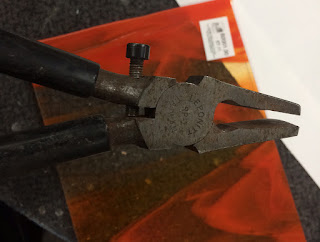There are
many opinions on how glass cuts when cold.
Some report cutting outdoors in sub-freezing temperatures, others that
only warm glass cuts well. I decided to
see what scientific information there may be on this idea.
The Science
The
scientific literature mostly concentrates on the effects at higher temperatures
than we are concerned with. However,
there are some things that are applicable, and some of these effects of temperature are outlined below.
·
High
humidity results in loss of strength.
·
The
strength of glass is reduced by 25% at 100°C compared to 0°C.
·
Glass
needs several days to be at an even temperature throughout.
·
Variance
in temperature across the glass causes unwanted breakages.
·
Colder
glass becomes more brittle due to loss of elasticity.
·
Hardness
of glass increases with decreasing temperature.
The terms of
strength, hardness and brittleness have scientific definitions that are hard to
apply to the everyday glass cutting that we do.
Strength may or may not have applicability to glass cutting. Elasticity may or may not be an important
factor in cutting. Surface hardness may
play a part in cutting while cold.
Applicability of the Science
However some
things seem to apply.
High humidity
results in loss of strength. This may be
a factor in low temperature cutting. The
humidity in a relatively closed environment increases with the reduction in
temperature. Breaking glass is about the
creation of a weakness in the glass along the score line. In so far as strength is a factor in the
break running along the score line, this may be an element in cold glass
cutting. If the whole glass is weaker,
the difference in strength at the score line is less and so promotes unwanted
breaks.
Variance of
the temperature of the glass throughout the substance of the glass promotes
unwanted breakages. Perhaps the cold
glass that is difficult to cut is not equally cold throughout. Certainly a number of people report that they
store their large glass outdoors and can still score and break the glass during the winter perfectly
well before bringing it into the studio.
Glass becomes
more brittle with decreasing temperature, and it also becomes harder. Perhaps these two elements are a factor in
controlling breakages. If the glass is
both harder and more brittle, a different scoring method is required.
The way in
which glass at any temperature breaks is related to the force of the score, the
speed of the score and the angle of the cutting wheel. If the glass is both harder (at the surface)
and more brittle it requires less scoring force or a blunter wheel angle. The more blunt the wheel on a thicker (i.e.
stronger) glass, the more vertical the stress lines are created in the
glass. So in a cold and harder glass, a
blunter wheel angle seems appropriate, even though the glass is not thicker.
It is not
usual for people to have cutting wheels of different angles, so an easier,
although more skilled, approach is to reduce the scoring force in cold
conditions. Reducing the force in scoring a hard
and brittle glass causes the stress lines to be more vertical than increased
forces do. Increased forces cause lateral
lines of stress to be created, leading to unwanted breakages.
Secondly, the
glass being more brittle, less force in breaking stress is required. As the glass becomes colder, the less elastic it is. This elasticity is an important element in breaking the glass at room temperatures. The score needs to be run gently to
counteract the loss of elasticity and the consequent increase in the brittle strength of the glass.
Conclusions
My conclusion,
after the reading I’ve done, is that cold glass becomes slightly stronger and more
brittle than room temperature glass, and so requires a slightly different
method of cutting. This difference is to reduce the pressure of scoring and the
force of breaking (applying stress to the glass).
Of course you can warm the glass up before scoring it, but the research seems to indicate that significantly long times are required to equalise the temperature throughout.


























